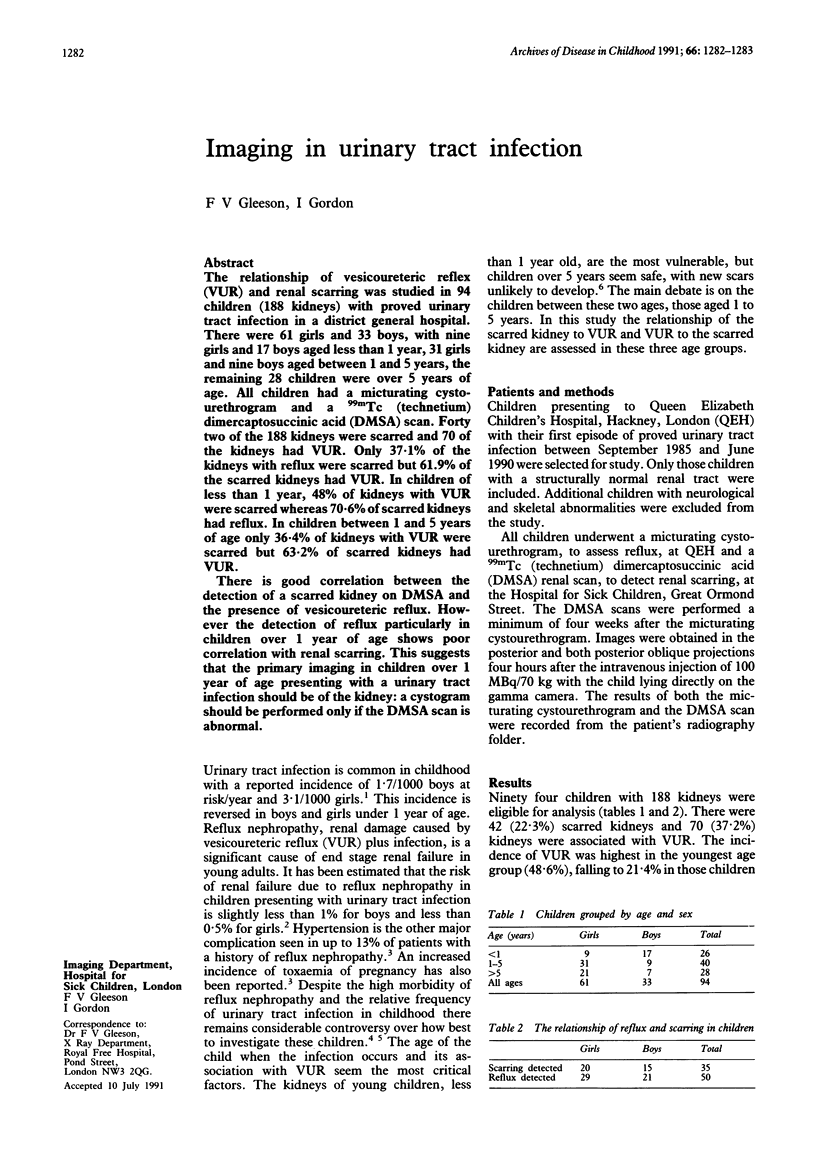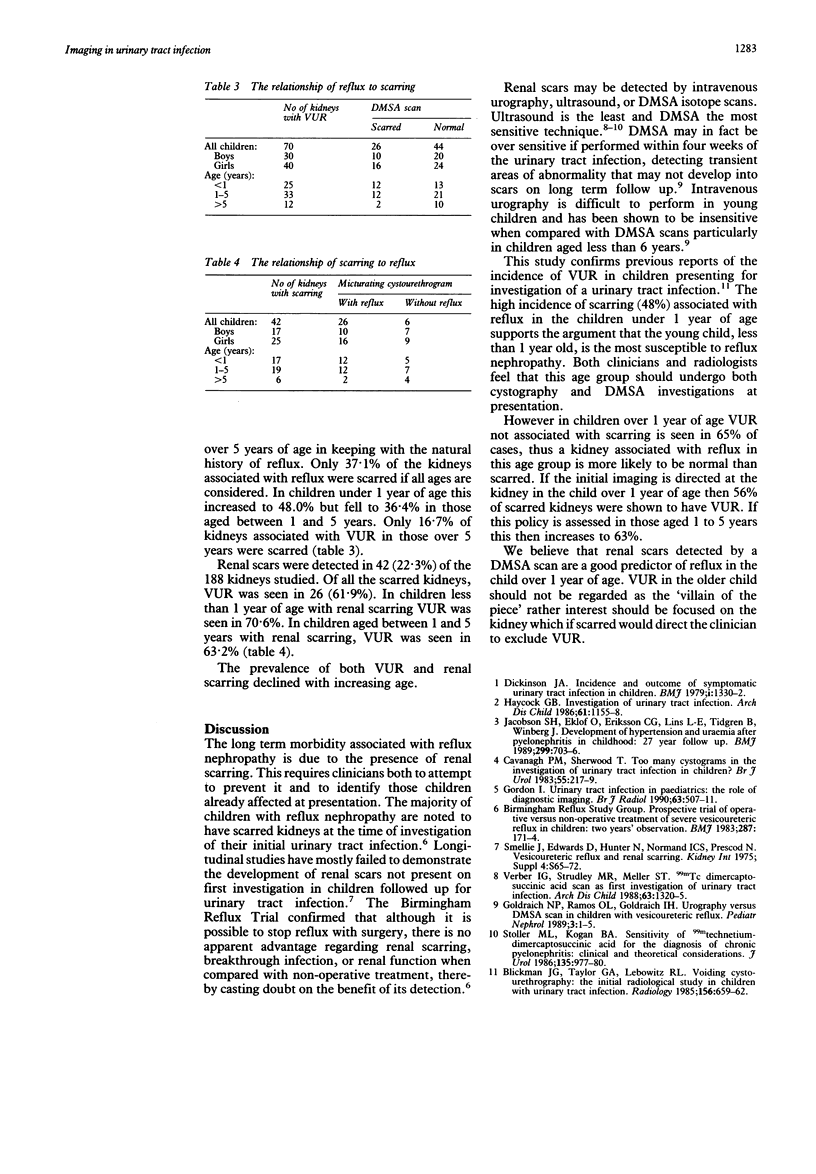Abstract
The relationship of vesicoureteric reflex (VUR) and renal scarring was studied in 94 children (188 kidneys) with proved urinary tract infection in a district general hospital. There were 61 girls and 33 boys, with nine girls and 17 boys aged less than 1 year, 31 girls and nine boys aged between 1 and 5 years, the remaining 28 children were over 5 years of age. All children had a micturating cystourethrogram and a 99mTc (technetium) dimercaptosuccinic acid (DMSA) scan. Forty two of the 188 kidneys were scarred and 70 of the kidneys had VUR. Only 37.1% of the kidneys with reflux were scarred but 61.9% of the scarred kidneys had VUR. In children of less than 1 year, 48% of kidneys with VUR were scarred whereas 70.6% of scarred kidneys had reflux. In children between 1 and 5 years of age only 36.4% of kidneys with VUR were scarred but 63.2% of scarred kidneys had VUR. There is good correlation between the detection of a scarred kidney on DMSA and the presence of vesicoureteric reflux. However the detection of reflux particularly in children over 1 year of age shows poor correlation with renal scarring. This suggests that the primary imaging in children over 1 year of age presenting with a urinary tract infection should be of the kidney: a cystogram should be performed only if the DMSA scan is abnormal.
Full text
PDF

Selected References
These references are in PubMed. This may not be the complete list of references from this article.
- Blickman J. G., Taylor G. A., Lebowitz R. L. Voiding cystourethrography: the initial radiologic study in children with urinary tract infection. Radiology. 1985 Sep;156(3):659–662. doi: 10.1148/radiology.156.3.4040642. [DOI] [PubMed] [Google Scholar]
- Cavanagh P. M., Sherwood T. Too many cystograms in the investigation of urinary tract infection in children? Br J Urol. 1983 Apr;55(2):217–219. doi: 10.1111/j.1464-410x.1983.tb06560.x. [DOI] [PubMed] [Google Scholar]
- Dickinson J. A. Incidence and outcome of symptomatic urinary tract infection in children. Br Med J. 1979 May 19;1(6174):1330–1332. doi: 10.1136/bmj.1.6174.1330. [DOI] [PMC free article] [PubMed] [Google Scholar]
- Goldraich N. P., Ramos O. L., Goldraich I. H. Urography versus DMSA scan in children with vesicoureteric reflux. Pediatr Nephrol. 1989 Jan;3(1):1–5. doi: 10.1007/BF00859614. [DOI] [PubMed] [Google Scholar]
- Gordon I. Urinary tract infection in paediatrics: the role of diagnostic imaging. Br J Radiol. 1990 Jul;63(751):507–511. doi: 10.1259/0007-1285-63-751-507. [DOI] [PubMed] [Google Scholar]
- Haycock G. B. Investigation of urinary tract infection. Arch Dis Child. 1986 Dec;61(12):1155–1158. doi: 10.1136/adc.61.12.1155. [DOI] [PMC free article] [PubMed] [Google Scholar]
- Jacobson S. H., Eklöf O., Eriksson C. G., Lins L. E., Tidgren B., Winberg J. Development of hypertension and uraemia after pyelonephritis in childhood: 27 year follow up. BMJ. 1989 Sep 16;299(6701):703–706. doi: 10.1136/bmj.299.6701.703. [DOI] [PMC free article] [PubMed] [Google Scholar]
- Stoller M. L., Kogan B. A. Sensitivity of 99mtechnetium-dimercaptosuccinic acid for the diagnosis of chronic pyelonephritis: clinical and theoretical considerations. J Urol. 1986 May;135(5):977–980. doi: 10.1016/s0022-5347(17)45945-3. [DOI] [PubMed] [Google Scholar]
- Verber I. G., Strudley M. R., Meller S. T. 99mTc dimercaptosuccinic acid (DMSA) scan as first investigation of urinary tract infection. Arch Dis Child. 1988 Nov;63(11):1320–1325. doi: 10.1136/adc.63.11.1320. [DOI] [PMC free article] [PubMed] [Google Scholar]


